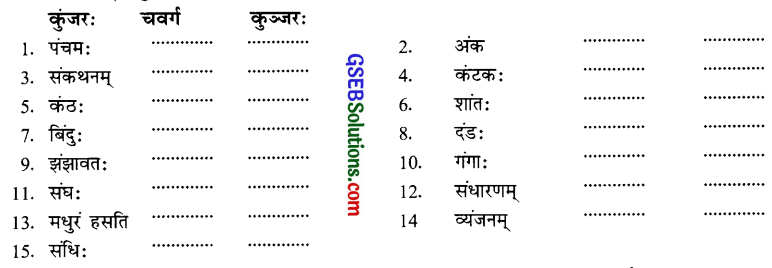Gujarat Board GSEB Solutions Class 10 Sanskrit Grammar अभ्यास 6 सन्धिः Important Questions and Answers Notes Pdf.
Gujarat Board Class 10 Sanskrit Grammar अभ्यास 6 सन्धिः
GSEB Class 9 Sanskrit सन्धिः Textbook Questions and Answers
1. उदाहरणानुसारं पदेषु अनुनासिकं लिखत।
उदाहरणम् – शंभु (प-वर्ग) शम्भुः।
- पंडितः
- अहंकारः
- चंपा
- भंजयितुम्
उत्तरम्:
- पण्डितः
- अहङ्कारः
- चम्पा
- भञ्जयितुम्
![]()
2. निम्नलिखितानि वाक्यानि अनुस्वारप्रयोगपूर्वकं पुनः लिखत।
- प्रतीक्षाम् कर्तुम् अर्हसि त्वम्।
- पूर्वम् अत्र अष्टादशविद्यायाः पठनम् पाठनम् च भवति स्म।
- अहम् त्वाम् कस्यचित् गृप्तचरम् मन्ये।
- सत्यम् तपो ज्ञानम् अहिंसताम् च विद्वत्प्रणामम् च सुशीलताम् च।
उत्तरम्:
- प्रतीक्षा कर्तुम् अर्हसि त्वम्।
- पूर्वम् अत्र अष्टादशविद्यायाः पठनम् च भवति स्म।
- अहं त्वां कस्यचित् गुप्तचरं मन्ये।
- सत्यं तपो ज्ञानम् अहिंसतां च विद्वत्प्रणामं च सुशीलतां च।
![]()
3. उदाहरणानुसारं वाक्येषु अनुनासिकं परसवर्णत्वेन परिवर्त्य लिखत।
उदाहरणाम् – फलं खादामि। – फलङ् खदामि।
- भद्रमिदं न पश्यामि।
- अश्रद्धेयं प्रियं प्राप्त सौभद्रः ग्रहणं गतः।
- स्वकीयं प्रयोजनं च संपादयति।
- अहं द्वितीयं बिलं यास्यामि इति।
उत्तरम्:
- भद्रमिदन्न पश्यामि।
- अश्रद्धेयम्प्रियम्प्राप्त सौभद्रः ग्रहणङगतः।
- स्वकीयम्प्रयोजनञ्च सम्पादयति।
- अहन्द्वितीयाम्बिलं यास्यामि इति।
GSEB Class 9 Sanskrit सन्धिः Additional Important Questions and Answers
1. निम्नसन्धियुक्तानां पदानाम् अधीलिखितेभ्यः पदेभ्यः उचितं विच्छेदं चित्वा लिखत।
1. संत्यं वद –
(क) सत्य + वद
(ख) सत्यम् + वद
(ग) सत्यः + वद
(घ) सत्ययाः + वद
उत्तरम्:
(ख) सत्यम् + वद
2. धर्मं चर –
(क) धर्म + चर
(ख) धर्मः + चर
(ग) धर्मम् + चर
(घ) धर्मम + चरः
उत्तरम्:
(ग) धर्मम् + चर
![]()
3. श्रीमांश्चकास्ति –
(क) श्री + मानश्चकास्ति
(ख) श्रीमान + श्चकास्ति
(ग) श्रीमान् + चकास्ति
(घ) श्रीमानः + चकास्ति
उत्तरम्:
(ग) श्रीमान् + चकास्ति
4. ग्रामं यति –
(क) ग्रामम् + यति
(ख) ग्रामः + यति
(ग) ग्राम + यति
(घ) ग्रामान् + यति
उत्तरम्:
(क) ग्रामम् + यति
![]()
2. अनुनासिकं परसवर्णत्वेन परिवर्त्य लिखत।
उदाहरण-वर्गसहितम् अनुनासिक पदं लिखत।

उत्तरम्:

सन्धिः Read the following sentences:
1. अहं जलं पातुम् इच्छामि।
2. तडागं गन्तुं निर्गच्छति।
In above sentences, you can see the dot on the words like अहं जलं तडागं and गन्तुं. It is called अनुस्वार. In Sanskrit it is considered to be an independent letter – स्वतन्त्र वर्ण. Mouth and nose both are used to pronounce it. In short, it is pronounced like म्.
Two kinds of अनुस्वार are found – (I) used at the end of a word in a sentence and example: बालक: पुस्तक पठति and (2) between the word. example: दंडा:। In the context of these two kinds of अनुस्वार main rules of Sandhi are as follows:
![]()
1. If म् occurs at the end of word used in a sentence and is followed by a word (beginning) starting with a consonant, अनुस्वार() is put in place of (म्.). example: अहं जलं पातुम् इच्छामि। In this sentence, you can see that there is letter at the end of the word म् and is followed by word ft which begins with a consonant. Hence turns into म् and is written as अहं. In the same way is turned into अनुस्वार in जलं. But म् is not turned into अनुस्वार in पातुम् because it is followed by इच्छामि which begins not with a consonant but with a vowel. (If any word beginning with consonant would have been used, it would have turned पद अनुस्वार () example: अहं जलं पातुं गच्छामि।
2. If अनुस्वार occuring in between the word is followed by any consonant (except श् ष्, स्, ह् Ushmakshara – उष्माक्षर and Antahstha – अन्तःस्थ letter य, र, ल, व्) then in place of that अनुस्वार Parasavarna परसवर्ण i.e., the fifth letter Nasal (अनुनासिक). (i.e., ङ्, ञ्, ण, न् and म्) of that particular Varga – वर्ग to which the consonant belongs is written. e.g. दंडा:। Here dot on the letter द is अनुस्वार. It is followed by letter ड, so the fifth letter ण of that वर्ग (ट् ठ् ड् ढ् ण – ट वर्ग) to which belongs will be placed, so it is written as दण्ड:।

Considering this, if अनुस्वार is followed by a letter: क्, ख्, ग्, घ, ङ् is placed in the place of अनुस्वार example: अंक: > अङ्कः। पंखः > पङ्खः। गंगा > गङ्गा। संघ > सङ्घः Same procedure should be followed for Sandhi of letter of other वर्गs.